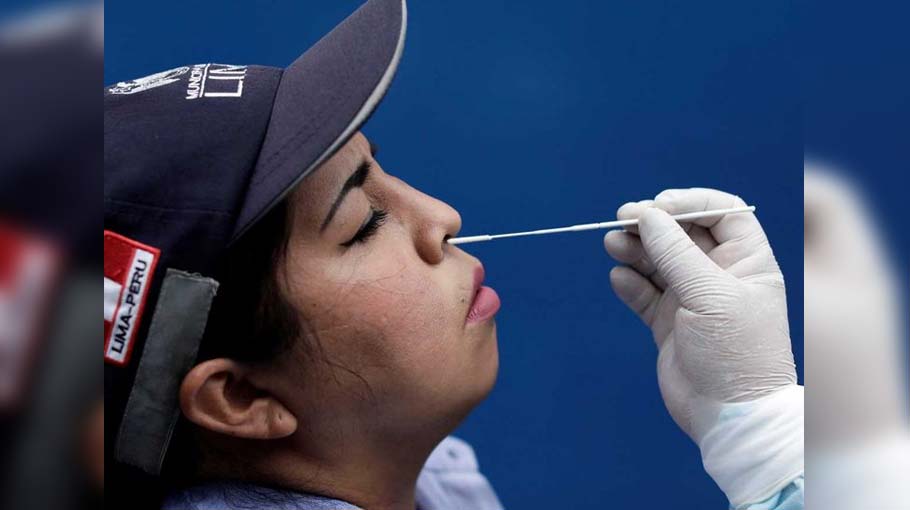Why we should not ignore the Omicron threat
Safety protocol must be followed diligently to keep out the heavily mutated variant

A woman gets tested for COVID-19 as Peru raised its pandemic alert level in various cities and tightened some restrictions due to a third wave of infections caused by the spread of the Omicron variant, in Lima on January 6, 2022.
Image Credit: Reuters
Omicron spreads very fast but is not dangerous. Its infection is mild, and recovery is swift. You hear this frequently, and it could push us down a treacherous path. This is precisely why the World Health Organisation sent out a stark warning on Thursday. Simply put, there’s no such thing as a mild coronavirus. Even a less infectious strain could be deadly to people with compromised immunity or underlying medical conditions.
The chatter about Omicron being a mild strain can lull people into a false sense of security. I too have been guilty of that. I have been treating Omicron with less dread. That’s in comparison with Delta, perhaps the most virulent strain of all.
The standard COVID safety protocol is our best recourse. Mask up,
wash hands and keep a safe distance from others. That has worked
well, and it will help ward off Omicron too. And don't forget the booster shot
Having said that, not once have I let my guard down. When I was preparing for an India trip, Omicron showed up in South Africa and Botswana. True, I was worried about the record mutations that increased its transmissibility, but I took comfort in its decreased severity of infections reported from Gauteng province in South Africa. I was double vaccinated too. So I went ahead with my travel plan and returned unscathed.
What I see around me is worrying. Lots of relatives and friends have been afflicted by COVID-19. Most of them are fully vaccinated, so they have largely had milder symptoms and recovered quickly.
I’m not sure whether it was due to Omicron or any other variant. But what’s certain is that more people are catching COVID now. So this is no time to dismiss the threat of Omicron or any other variant.
Omicron is highly transmissive and can kill; it’s overwhelming hospitals, and there have been fatalities. That’s what WHO chief Tedros Adhanom Ghebreyesus said on Thursday. It’s also an appeal to people not to let their guard down — a reminder to people worldwide that the COVID threat is far from over.
When the WHO chief talks about the pandemic, you have to sit up and take notice. Tedros said record numbers of people are catching COVID from the new variant, and it is rapidly outpacing the previously-dominant Delta variant in many countries.
“While Omicron does appear to be less severe compared to Delta, especially in those vaccinated, it does not mean it should be categorised as mild,” Tedros warned.
I scoured the internet to see how rampant Omicron has been. Because all you hear is how mild is this variant apart from its propensity to spread very fast and kill the occasional patient. I couldn’t get the latest figures, but here’s what I found out.
The United States set a global daily record of 1 million cases on January 3, but they have not translated into skyrocketing hospitalisations and soaring deaths. On December 28, Centers for Disease Control and Prevention Director Rochelle Walensky attributed the spike in cases largely to Omicron but added that hospitalisations and deaths remained low. That, she said, could be because hospitalisations tend to lag cases by two weeks and may also be due to milder disease among the vaccinated.
In Britain, there have been 12 Omicron deaths in December. The government’s Life Sciences Adviser John Bell said hospitalisations have increased due to the spread of Omicron, but the disease “appears to be less severe and many people spend a relatively short time in hospital”. Fewer patients required high-flow oxygen, and the average length of stay was to three days, the Guardian quoted the regius professor of medicine at Oxford University as saying.
South Africa was one of the first countries to identify the variant, but the infections there have been less severe. But medical experts warn that the country is an outlier since it has a young population.
The heavily mutated Omicron has sread to at least 130 countries since it was first discovered in November and has overtaken Delta as the dominant strain worldwide. Case numbers have soared to an all-time high, but the hospitalisation and death rates are often lower than at other phases in the pandemic. “What we are seeing now is … the decoupling between the cases and the deaths,” WHO Incident Manager Abdi Mahamud said in Geneva.
The threat is more in countries where a large proportion of the population remains unvaccinated. It could overwhelm the medical infrastructure in such countries, and deaths could happen. This is what Tedros was referring to when he sounded the warning.
Any COVID virus strain has to be treated with abundant caution. And Omicron is reported to be around 30 per cent more transmissible. Therein lies the danger. The standard COVID safety protocol is our best recourse. Mask up, wash hands and keep a safe distance from others. That has worked well, and it will help ward off Omicron too. And don't forget the booster shot.
Shyam A. Krishna is Senior Associate Editor at Gulf News. He writes on health and sport.




